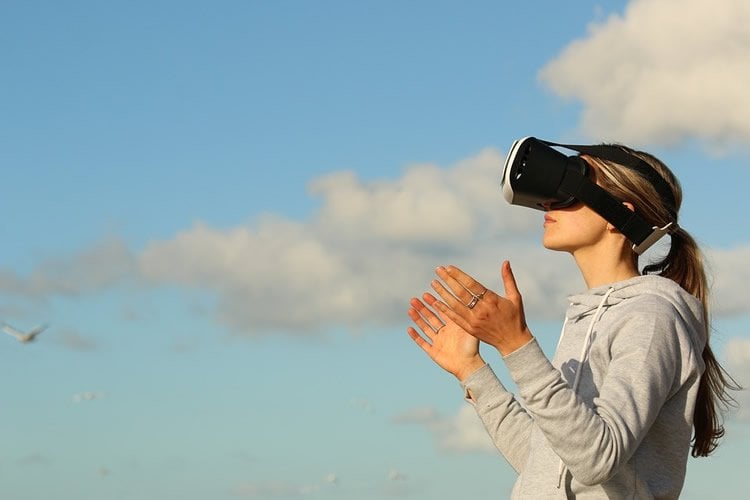Summary: Using virtual reality technology may allow people to regain motor control in damaged limbs, a new study reports.
Source: AFTAU.
Novel training may rehabilitate impaired limbs by allowing healthy limbs to lead “by example,” say TAU researchers.
A combination of traditional physical therapy and technology may improve the motor skills and mobility of an impaired hand by having its partner, more mobile hand lead by example through virtual reality training, new Tel Aviv University research suggests.
“Patients suffering from hemiparesis — the weakness or paralysis of one of two paired limbs — undergo physical therapy, but this therapy is challenging, exhausting, and usually has a fairly limited effect,” said lead investigator Prof. Roy Mukamel of TAU’s School of Psychological Sciences and Sagol School of Neuroscience, who conducted the research with his student Ori Ossmy. “Our results suggest that training with a healthy hand through a virtual reality intervention provides a promising way to repair mobility and motor skills in an impaired limb.” The research was published in Cell Reports.
Does the left hand know what the right hand is doing?
53 healthy participants completed baseline tests to assess the motor skills of their hands, then strapped on virtual reality headsets that showed simulated versions of their hands. The virtual reality technology, however, presented the participants with a “mirror image” of their hands — when they moved their real right hand, their virtual left hand would move.
In the first experiment, participants completed a series of finger movements with their right hands, while the screen showed their “virtual” left hands moving instead. In the next, participants placed motorized gloves on their left hands, which moved their fingers to match the motions of their right hands. Again, the headsets presented the virtual left hands moving instead of their right hands.
The research team found that when subjects practiced finger movements with their right hands while watching their left hands on 3D virtual reality headsets, they could use their left hands more efficiently after the exercise. But the most notable improvements occurred when the virtual reality screen showed the left hand moving while in reality the motorized glove moved the hand.
Tricking the brain
“We effectively tricked the brain,” said Prof. Mukamel.

“Technologically, these experiments were a big challenge,” Prof. Mukamel continued. “We manipulated what people saw and combined it with the passive, mechanical movement of the hand to show that our left hand can learn even when it is not moving under voluntary control.”
The researchers are optimistic that this research could be applied to patients in physical therapy programs who have lost the strength or control of one hand. “We need to show a way to obtain high-performance gains relative to other, more traditional types of therapies,” said Prof. Mukamel. “If we can train one hand without voluntarily moving it and still show significant improvements in the motor skills of that hand, we’ve achieved the ideal.”
The researchers are currently examining the applicability of their novel VR training scheme to stroke patients.
Funding: Funding provided by Japan Society for the Promotion of Science, Ministry of Education, Culture, Sports, Science and Technology Japan, Takeda Science Foundation.
Source: AFTAU
Image Source: NeuroscienceNews.com image is in the public domain.
Original Research:Full open access research for “Neural Network Underlying Intermanual Skill Transfer in Humans” by Ori Ossmy and Roy Mukamel in Cell Reports. Published online December 13 2016 doi:10.1016/j.celrep.2016.11.009
[cbtabs][cbtab title=”MLA”]AFTAU. “Virtual Reality May Help Improve Motor Skills in Damaged Limbs.” NeuroscienceNews. NeuroscienceNews, 17 December 2016.
<https://neurosciencenews.com/virtual-reality-limb-movement-5767/>.[/cbtab][cbtab title=”APA”]AFTAU. (20117, December 17). Virtual Reality May Help Improve Motor Skills in Damaged Limbs. NeuroscienceNews. Retrieved December 17, 2016 from https://neurosciencenews.com/virtual-reality-limb-movement-5767/[/cbtab][cbtab title=”Chicago”]AFTAU. “Virtual Reality May Help Improve Motor Skills in Damaged Limbs.” https://neurosciencenews.com/virtual-reality-limb-movement-5767/ (accessed December 17, 2016).[/cbtab][/cbtabs]
Abstract
Neural Network Underlying Intermanual Skill Transfer in Humans
Highlights
•Unimanual training also enhances performance in the untrained hand (cross-education)
•Real-time manipulation of visual feedback enhances magnitude of cross-education
•Yoking movement of untrained to trained hand further increases cross-education
•Functional connectivity with SPL during training predicts cross-education
Summary
Physical practice with one hand results in performance gains of the other (un-practiced) hand, yet the role of sensory feedback and underlying neurophysiology is unclear. Healthy subjects learned sequences of finger movements by physical training with their right hand while receiving real-time movement-based visual feedback via 3D virtual reality devices as if their immobile left hand was training. This manipulation resulted in significantly enhanced performance gain with the immobile hand, which was further increased when left-hand fingers were yoked to passively follow right-hand voluntary movements. Neuroimaging data show that, during training with manipulated visual feedback, activity in the left and right superior parietal lobule and their degree of coupling with motor and visual cortex, respectively, correlate with subsequent left-hand performance gain. These results point to a neural network subserving short-term motor skill learning and may have implications for developing new approaches for learning and rehabilitation in patients with unilateral motor deficits.
“Neural Network Underlying Intermanual Skill Transfer in Humans” by Ori Ossmy and Roy Mukamel in Cell Reports. Published online December 13 2016 doi:10.1016/j.celrep.2016.11.009






